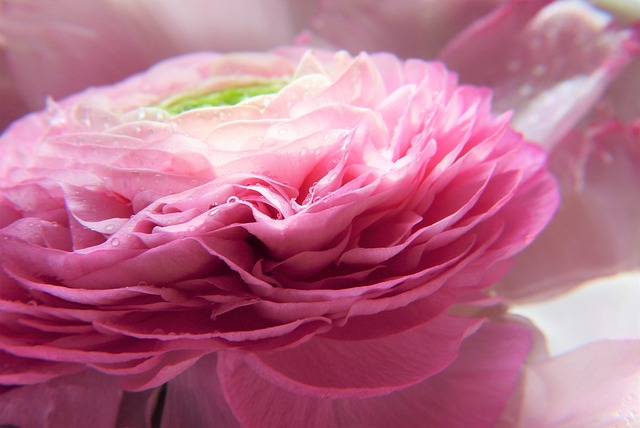Introduction to Ranunculus
Welcome to our comprehensive guide on Ranunculus, one of the most spectacular flowers in the garden. Known for their vibrant, multi-layered blooms and wide range of colors, Ranunculus are a favorite among gardeners and floral enthusiasts. This guide will provide you with all the necessary information to grow and care for these stunning flowers, ensuring a dazzling display in your garden.
Botanical Overview
Understanding Ranunculus’ Botanical Roots
- Common Name: Ranunculus, Buttercup
- Scientific Name: Ranunculus asiaticus
- Family: Ranunculaceae Ranunculus species are known for their lush, paper-like petals and bright hues. Native to Asia Minor and southeastern Europe, these perennials are grown as annuals in many parts of the world due to their sensitivity to extreme cold.
Varieties of Ranunculus
Exploring the Diverse World of Ranunculus
- ‘Tecolote Giant’ Ranunculus: Known for their large, rose-like flowers and tall stems, perfect for cut floral arrangements.
- ‘Bloomingdale’ Ranunculus: Compact and vibrant, ideal for container gardening.
- ‘Mache’ Ranunculus: Features large double flowers and is known for its excellent performance in cooler climates. Each variety offers a unique palette of colors and sizes, making Ranunculus a versatile choice for any garden design.
Planting and Growth Conditions
Ideal Growing Zones for Ranunculus
To cultivate Ranunculus successfully, it’s important to consider the ideal growing zones for these vibrant flowers. Understanding the appropriate climate conditions ensures optimal growth and abundant blooming.
Hardiness Zones
- Preferred Zones: Ranunculus typically thrives in USDA Hardiness Zones 8 through 11, although they can be grown as annuals in cooler climates.
- Temperature Tolerances: Ranunculus prefer mild winters and cool springs. They may struggle in regions with extreme heat or cold, so it’s essential to choose the right planting time and location based on your local climate.
Climate Considerations
- Sunlight: Ranunculus prefer full sun to partial shade, although they can tolerate some shade in hotter climates.
- Temperature and Moisture: They thrive in climates with moderate temperatures and consistent moisture. Avoid planting them in areas prone to extreme heatwaves or heavy rainfall, as these conditions can stress the plants.
Adapting to Your Local Environment
- Microclimates: Consider the microclimates within your garden when planting Ranunculus. Areas with slightly cooler temperatures or better drainage may offer more favorable conditions for these flowers.
- Seasonal Care: In cooler zones, consider planting Ranunculus as annuals or providing protection during cold snaps. Mulching can help regulate soil temperature and moisture levels, especially during winter.
By selecting the appropriate planting location and considering your local climate and microclimates, you can create the perfect environment for Ranunculus to thrive and bloom beautifully in your garden. Be sure to consult with local gardening experts or extension services for additional advice tailored to your specific growing zone.
Care and Maintenance
Keeping Your Ranunculus Thriving
- Watering: Keep the soil consistently moist but not waterlogged to prevent rot.
- Fertilizing: Use a low-nitrogen, high-potassium fertilizer to encourage robust blooms.
- Deadheading: Remove spent flowers regularly to promote continuous blooming. Regular maintenance ensures that Ranunculus plants remain vigorous and blooming brilliantly throughout the season.
Benefits and Uses
The Multifaceted Appeal of Ranunculus
- Aesthetic Appeal: Adds a burst of color and elegance to garden beds, borders, and containers.
- Cut Flowers: Ranunculus are excellent for bouquets and arrangements, offering long vase life and stunning floral displays.
- Pollinator Friendly: Attracts bees and other beneficial insects to the garden. Incorporating Ranunculus into your garden not only enhances its beauty but also supports local biodiversity.
Potential Problems
Navigating Common Issues with Ranunculus
- Pests: Watch out for aphids and spider mites which can occasionally plague Ranunculus.
- Diseases: Fungal diseases such as powdery mildew and botrytis blight can occur, especially in damp conditions.
- Environmental Stress: Ranunculus bulbs can rot in overly wet soil, so ensure proper drainage. Proactive care and monitoring can help prevent most problems and keep your Ranunculus plants healthy.
Conclusion Ranunculus are truly a joy to grow, with their spectacular blooms that seem to capture the very essence of spring. Whether you’re a novice gardener or a seasoned horticulturist, these flowers offer visual delight and a rewarding gardening experience. With the right care, Ranunculus will provide vibrant color and life to your garden year after year.












You must be logged in to post a comment.